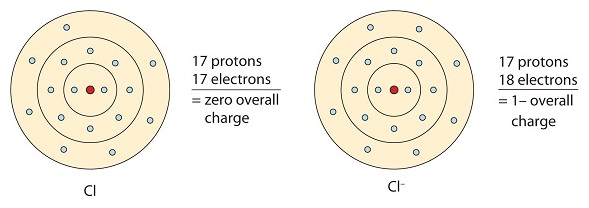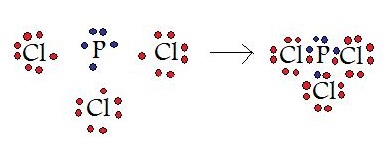What Do Ionic Bonds Form
Ionic and Covalent Bonds
- Page ID
- 839
There are many types of chemical bonds and forces that demark molecules together. The 2 most bones types of bonds are characterized as either ionic or covalent. In ionic bonding, atoms transfer electrons to each other. Ionic bonds require at least one electron donor and one electron acceptor. In contrast, atoms with the same electronegativity share electrons in covalent bonds, because neither atom preferentially attracts or repels the shared electrons.
Introduction
Ionic bonding is the complete transfer of valence electron(s) between atoms. It is a type of chemical bond that generates two oppositely charged ions. In ionic bonds, the metal loses electrons to become a positively charged cation, whereas the nonmetal accepts those electrons to get a negatively charged anion. Ionic bonds require an electron donor, oft a metal, and an electron acceptor, a nonmetal.
Ionic bonding is observed because metals have few electrons in their outer-about orbitals. Past losing those electrons, these metals tin achieve noble gas configuration and satisfy the octet rule. Similarly, nonmetals that take close to 8 electrons in their valence shells tend to readily take electrons to accomplish noble gas configuration. In ionic bonding, more 1 electron can be donated or received to satisfy the octet rule. The charges on the anion and cation correspond to the number of electrons donated or received. In ionic bonds, the net charge of the compound must be zero.

This sodium molecule donates the lone electron in its valence orbital in order to achieve octet configuration. This creates a positively charged cation due to the loss of electron.

This chlorine atom receives one electron to achieve its octet configuration, which creates a negatively charged anion.
The predicted overall free energy of the ionic bonding process, which includes the ionization energy of the metal and electron affinity of the nonmetal, is commonly positive, indicating that the reaction is endothermic and unfavorable. Notwithstanding, this reaction is highly favorable because of the electrostatic attraction between the particles. At the ideal interatomic distance, allure between these particles releases enough energy to facilitate the reaction. About ionic compounds tend to dissociate in polar solvents considering they are often polar. This miracle is due to the opposite charges on each ion.
Example \(\PageIndex{1}\): Chloride Salts
.jpg?revision=2)
In this case, the sodium atom is altruistic its ane valence electron to the chlorine atom. This creates a sodium cation and a chlorine anion. Observe that the net charge of the resulting chemical compound is 0.
.jpg?revision=2)
In this example, the magnesium atom is donating both of its valence electrons to chlorine atoms. Each chlorine atom can only take 1 electron before it can achieve its noble gas configuration; therefore, 2 atoms of chlorine are required to accept the ii electrons donated by the magnesium. Discover that the net charge of the compound is 0.
Covalent Bonding
Covalent bonding is the sharing of electrons betwixt atoms. This type of bonding occurs betwixt two atoms of the same element or of elements shut to each other in the periodic table. This bonding occurs primarily between nonmetals; however, it tin can also be observed betwixt nonmetals and metals.
If atoms have similar electronegativities (the aforementioned affinity for electrons), covalent bonds are most likely to occur. Because both atoms have the same affinity for electrons and neither has a tendency to donate them, they share electrons in order to achieve octet configuration and get more than stable. In addition, the ionization free energy of the atom is too large and the electron affinity of the atom is too small for ionic bonding to occur. For example: carbon does not course ionic bonds because it has iv valence electrons, one-half of an octet. To class ionic bonds, Carbon molecules must either gain or lose iv electrons. This is highly unfavorable; therefore, carbon molecules share their 4 valence electrons through unmarried, double, and triple bonds then that each cantlet tin achieve element of group 0 configurations. Covalent bonds include interactions of the sigma and pi orbitals; therefore, covalent bonds lead to formation of single, double, triple, and quadruple bonds.
Example \(\PageIndex{2}\): \(PCl_3\)

In this instance, a phosphorous atom is sharing its three unpaired electrons with three chlorine atoms. In the end product, all four of these molecules accept eight valence electrons and satisfy the octet rule.
Bonding in Organic Chemistry
Ionic and covalent bonds are the two extremes of bonding. Polar covalent is the intermediate type of bonding between the two extremes. Some ionic bonds contain covalent characteristics and some covalent bonds are partially ionic. For example, most carbon-based compounds are covalently bonded but can as well be partially ionic. Polarity is a measure of the separation of charge in a compound. A compound'due south polarity is dependent on the symmetry of the chemical compound and on differences in electronegativity between atoms. Polarity occurs when the electron pushing elements, found on the left side of the periodic tabular array, exchanges electrons with the electron pulling elements, on the right side of the tabular array. This creates a spectrum of polarity, with ionic (polar) at one extreme, covalent (nonpolar) at another, and polar covalent in the heart.
Both of these bonds are of import in organic chemistry. Ionic bonds are of import because they allow the synthesis of specific organic compounds. Scientists can manipulate ionic properties and these interactions in society to form desired products. Covalent bonds are especially of import since about carbon molecules interact primarily through covalent bonding. Covalent bonding allows molecules to share electrons with other molecules, creating long chains of compounds and allowing more complexity in life.
References
- Vollhardt, K. Peter C., and Neil E. Schore. Organic Chemical science Structure and Office. New York: W. H. Freeman, 2007.
- Petrucci, Ralph H. Full general Chemistry: Principles and Mod Applications. Upper Saddle River, NJ: Pearson Teaching, 2007.
- Brownish, Theodore L., Eugene H. Lemay, and Bruce E. Bursten. Chemistry: The Cardinal Scientific discipline. 6th ed. Englewood Cliffs, NJ: Prentice Hall, 1994.
Issues
1. Are these compounds ionic or covalent?

2. In the following reactions, indicate whether the reactants and products are ionic or covalently bonded.
a)

b) Clarification: What is the nature of the bail betwixt sodium and amide? What kind of bond forms between the anion carbon concatenation and sodium?

c)

Solutions
- ane) From left to correct: Covalent, Ionic, Ionic, Covalent, Covalent, Covalent, Ionic.
- 2a) All products and reactants are ionic.
- 2b) From left to right: Covalent, Ionic, Ionic, Covalent, Ionic, Covalent, Covalent, Ionic.
- 2c) All products and reactants are covalent.
What Do Ionic Bonds Form,
Source: https://chem.libretexts.org/Bookshelves/Organic_Chemistry/Supplemental_Modules_%28Organic_Chemistry%29/Fundamentals/Ionic_and_Covalent_Bonds
Posted by: owenscrind1984.blogspot.com


0 Response to "What Do Ionic Bonds Form"
Post a Comment